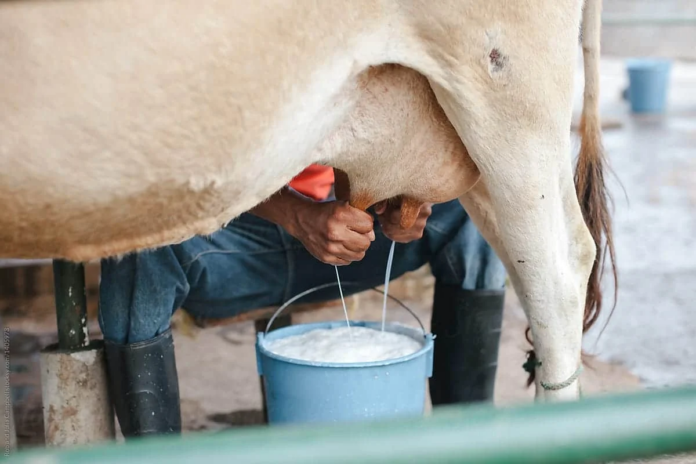If you are a dairy farmer, you have probably encountered a situation where your dairy cow stops giving you high milk production and you just can’t pinpoint why. For a start, there are several reasons why your cow may stop high milk production. Let us take a look at nine of these reasons:
1). Increased average days in milk: As dairy cows enter mid to later lactation, milk production naturally trails off with milk production peaking during early lactation. As the percentage of cows in mid to later lactation increases (increasing days in milk), milk production will be expected to be lower. This contributing factor to lower milk production might seem very obvious, but can provide a possible explanation or partial explanation which can easily be overlooked.
2). Lower body condition of early lactation cows: In early lactation, dairy cows cannot consume adequate amounts of energy to meet the energy needs for milk production and maintenance of the cow herself. As a result, early lactation cows are said to be in negative energy balance and rely on body stores of fat or adipose tissue to support the additional amounts of energy needed to support milk production they cannot consume.
If these stores are not present or are mobilized too quickly, cows often times will produce the amount of milk equal to the amount of energy they can consume. In other words, they will not milk as well as they could have or peak as high in milk production. Thin early lactation cows often are related to cows calving thinner than normal or metabolic disorders related to the transition back into the milking herd that result in cows going off feed and dropping in body condition quickly.
The proper feeding ration and the weight your cow should gain daily
3). More cows in the milk herd: Often-times cows are added to the milking string to improve cash flow without making accommodations for increased bunk space (hay, silage, and/or TMR) and/or resting space. Overcrowding at the feed bunk can decrease feed intake especially in fresh and early lactating cows resulting in lower milk production. Sometimes overcrowding with other contributing causes can result in lowered milk production even when it appears that no feeding and management practices have changed.
4). Thinner cows at calving: Dairy cows are the most efficient and cost effective at putting on body condition or fat stores when they are milking versus when they are dry. Thus, our management programs are geared toward putting condition on cows in mid to later lactation, having them in the proper condition at dry off, and maintaining that condition during the dry period. Hot temperatures can decrease or stop the growth of pasture grasses and legumes, thus decreasing forage availability and sometimes dry cows lose weight or body condition if alternative forages are not provided.
In addition, with higher grain costs, dry cows may not have been provided adequate amounts of grain to maintain body condition if forage quality was low. Dry cows that calve too thin will not have the energy reserves to milk well this next lactation, especially during early lactation.
5). Rebalanced rations to reflect quality of forages currently being fed: The quality and thus nutrient content of forages change between crop year, cuttings, and type of forage. In addition, yearly differences exist in the digestibility of forages by the rumen bacteria. These changes in NDF digestibility can greatly affect the amount of energy cows and, more importantly, bacteria receive from the forages and other feeds consumed.
A current forage analysis should be used to balance rations numerous times each year. Monthly ration balancing or review of rations being fed is recommended for the most economical and efficient use of forage resources. With the wide swings in commodity prices, this reevaluation becomes even more critical.
6). Limited grain in silage: With this summer’s drought and high temperatures during corn pollination, corn silage may contain limited amounts of grain and the amount of corn silage available to be fed may be limiting. These changes in the quality and quantity of corn silage potentially decrease the amount of energy coming from these forages. To try and compensate for the decreases seen in grain content, more energy needs to be added to these rations in the form of ground corn grain or other byproducts, increasing the cost to feed the milking herd.
At the same time, these alterations may alter the digestibility of starch and fiber fractions of the diet and the bacteria may not have the identical types and digestibility of energy sources compared to diets containing higher grain, corn silage diets. Bottom line, when the bacteria do not get adequate amounts of energy at specific times, they produce less end products cows can use to make milk and, as a result, milk production may be reduced.
Sometimes, these diets need to be tweaked over time to get the best combination. Working with your nutritionist and fine tuning these diets over time is the best way to achieve the desired results. Blending last year’s corn silage with this year’s has helped cows adjust to the differences and bridge the gaps. This may offer one explanation of why some herds have been able to hold milk production similar to previous years.
7). Changes in forages being fed: With reduced corn silage yields and multiple dry years, some dairy farmers have opted to include silage made from forage sorghum into diets for the milking herd. Granted these varieties most likely have higher digestibility than older varieties of forage sorghum, but they still contain less energy than higher-yielding, energy dense corn silage.
Can they work well in rations for milking cows? Yes, but your nutritionist needs to make sure the bacteria have the nutrients they need (carbohydrates and nitrogen or amino acid source) at the correct time. Thus, old recipes for grain mixes may not always work.
8). Problems when transitioning cows back into the milking herd: A smooth transition of cows back into the milking herd is critical to getting dairy cows to milk well in early lactation and rebred. Often-times, minimizing stress, caused by limited feed bunk space (recommend 36 inches per cow), cow comfort (provide effective heat abatement) and resting space, 3 weeks before calving through 3 weeks after calving, is the starting point.
Diets need to contain adequate amounts of effective fiber or chew factor for proper rumen fill, minerals and vitamins to prevent subclinical (no visible signs but blood calcium is low) milk fever, and adequate but not excess amounts of energy and protein. Subclinical problems are often not detected and can cause issues in fresh cows that result in decreased feed intake before or after calving, rapid losses in body condition, and decreased milk production and reproductive performance.
9). Other disease issues: Clinical cases of diseases, such as mastitis or metritis, can decrease milk production and reproductive efficiency. In addition, mycotoxins in feeds (forages as well as grains) also can decrease feed intake in herds and may affect performance. However, before dairy farmers blame mycotoxins for decreases seen in milk production and/or reproductive performance, other aspects of their feeding and management program should be examined and eliminated as potential causes first.








